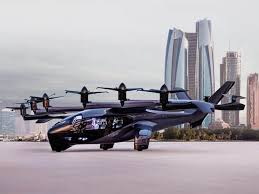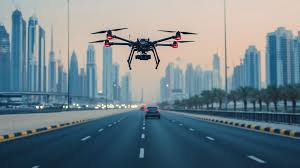Now Reading: “UAE’s Air Mobility Revolution: Flying Taxis Set to Change Travel 2025”
-
01
“UAE’s Air Mobility Revolution: Flying Taxis Set to Change Travel 2025”
“UAE’s Air Mobility Revolution: Flying Taxis Set to Change Travel 2025”

Table of Contents
In the heart of the Middle East, the United Arab Emirates (UAE) is making headlines once again—but this time not for its skyscrapers, luxury resorts, or desert safaris. The country is fast becoming a global leader in air mobility, promising to change the way people travel across its bustling cities and beyond.
The concept of air mobility—especially Advanced Air Mobility (AAM)—involves using electric vertical take-off and landing (eVTOL) aircraft, air taxis, and even drones to transport people and cargo efficiently. While this idea may have once sounded like a science fiction dream, the UAE is making it a reality, faster than many expected.
Why Air Mobility Matters for the UAE

With cities like Dubai and Abu Dhabi growing rapidly and traffic congestion becoming a serious issue, the UAE government and private companies are pushing for air mobility solutions to ease urban transport problems.
In 2023, Dubai’s Roads and Transport Authority (RTA) announced a bold plan to introduce flying taxis by 2026. The proposed service will reduce travel time significantly—for example, a 45-minute car ride from Dubai International Airport to Downtown Dubai could shrink to just 10 minutes by air taxi.
Besides easing traffic, air mobility supports the country’s Vision 2030 goals to promote green energy and sustainable technology. Most air vehicles under development are fully electric, promising zero emissions, lower noise, and higher energy efficiency compared to traditional helicopters or small airplanes.
Who’s Leading the Air Mobility Charge in UAE?

Several major global companies are working closely with UAE authorities to make this air revolution possible.
- Joby Aviation (USA):
Joby has signed agreements with Dubai officials to offer commercial air taxi services. Their eVTOL aircraft can carry up to four passengers and fly distances of 150-200 kilometers on a single charge. - Volocopter (Germany):
Volocopter’s air taxi—a sleek, drone-like vehicle—is already being tested in Dubai. The company plans to roll out these services to passengers before Expo City Dubai 2030, boosting tourism and business travel alike. - EHang (China):
EHang’s autonomous drones are being considered for short-distance cargo deliveries and emergency medical services, a crucial sector for improving the country’s healthcare response system.
Government Support is Strong
The UAE government isn’t standing on the sidelines. Instead, it’s driving air mobility progress through policy, funding, and infrastructure development.
- Dubai RTA’s Air Taxi Initiative:
Plans are underway to build vertiports—specialized landing and take-off stations—across the city. Four main locations have been proposed, covering business hubs, airports, and popular tourist destinations. - Regulatory Framework Development:
Safety is the top concern. The UAE’s General Civil Aviation Authority (GCAA) is working closely with international bodies to develop rules for air taxi operations, pilot licensing, maintenance standards, and airspace management. - Incentives for Startups:
Innovation hubs like Hub71 in Abu Dhabi are offering grants, workspace, and mentorship for startups working on air mobility tech. This could position UAE as a global hub for flying vehicle R&D.
Benefits for Economy and Environment
The economic potential of air mobility is huge. A report by Morgan Stanley estimates that the global market for urban air mobility could hit $1 trillion by 2040. The UAE is well-placed to claim a slice of this market, creating jobs in manufacturing, maintenance, piloting, and logistics.
Environmental advantages are also key. As the world shifts away from fossil fuels, electric flying vehicles provide a cleaner alternative to traditional transport methods. UAE leaders hope this aligns with their commitments to net-zero carbon emissions by 2050.
Challenges on the Flight Path
Of course, challenges remain. Air mobility systems must prove they are:
- Safe:
Public confidence depends on flawless safety records. Developers must demonstrate redundancy systems and backup technologies to prevent accidents. - Affordable:
If air taxis cost as much as helicopters today, they will only serve the wealthy. Reducing costs to compete with car or metro travel is essential. - Infrastructure-ready:
Cities need vertiports, charging stations, and maintenance facilities. These must be built in time to support commercial operations. - Socially accepted:
Will people feel comfortable boarding an aircraft flown by a computer—or without a pilot at all? Education campaigns will be needed to build trust.
A New Era of Mobility is Near
Despite these hurdles, the UAE’s confidence in air mobility remains high. Authorities are betting that their mix of visionary planning, strong financial backing, and openness to technology will make the country a global pioneer in this field.
For the average resident or tourist in Dubai or Abu Dhabi, this could mean skipping traffic jams and soaring across the skyline within just a few years. Business executives could reach meetings in minutes, and emergency responders could save lives faster than ever.
The sky may soon become as busy as the streets below, and the UAE is determined to be among the first nations to unlock this exciting future.
Conclusion
The UAE’s ambition to lead in air mobility reflects its broader goal of becoming a global technology hub. While full-scale air taxi services may still take a few years to become mainstream, the groundwork is being laid today.
As Dubai and Abu Dhabi race to build vertiports, approve flying vehicles, and educate the public, the world watches with curiosity: Will the UAE become the first country where flying cars are as common as ground taxis?
One thing is clear—the future of transportation is not on the road, but in the air.
Read More:-Shobha Realty Launches Its Most Luxurious Project Yet—Full Details Inside 2025


















